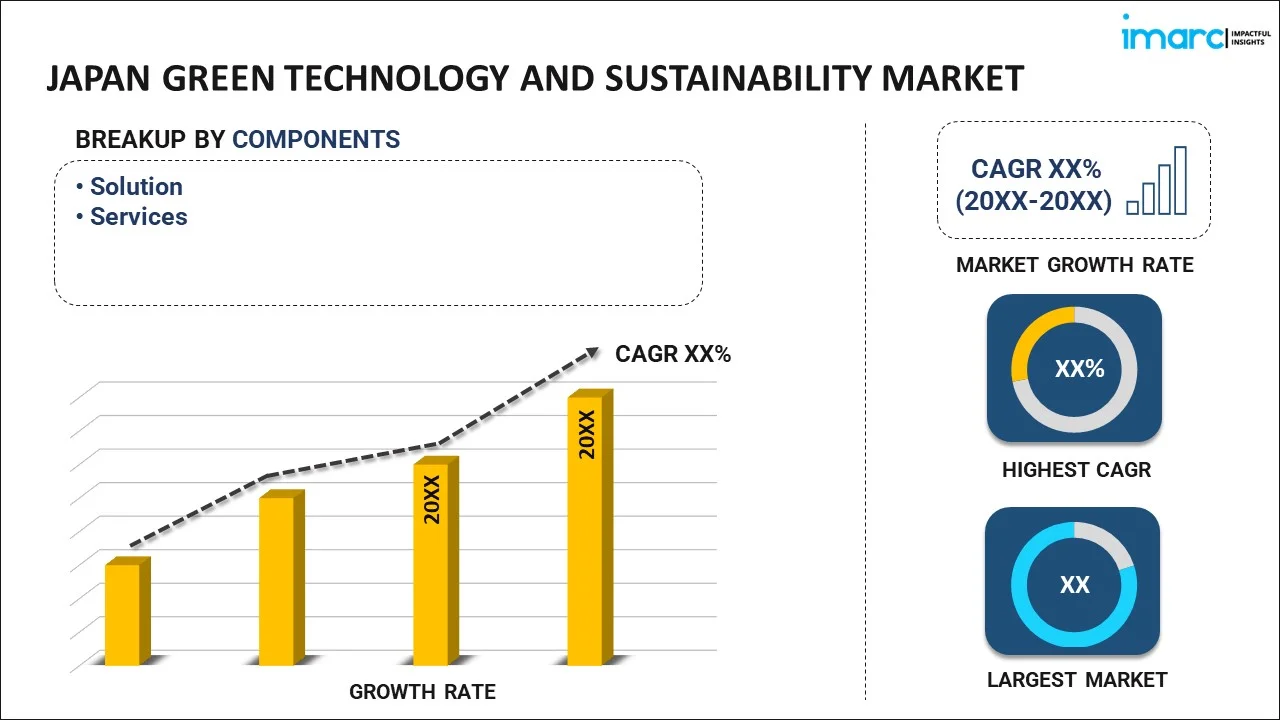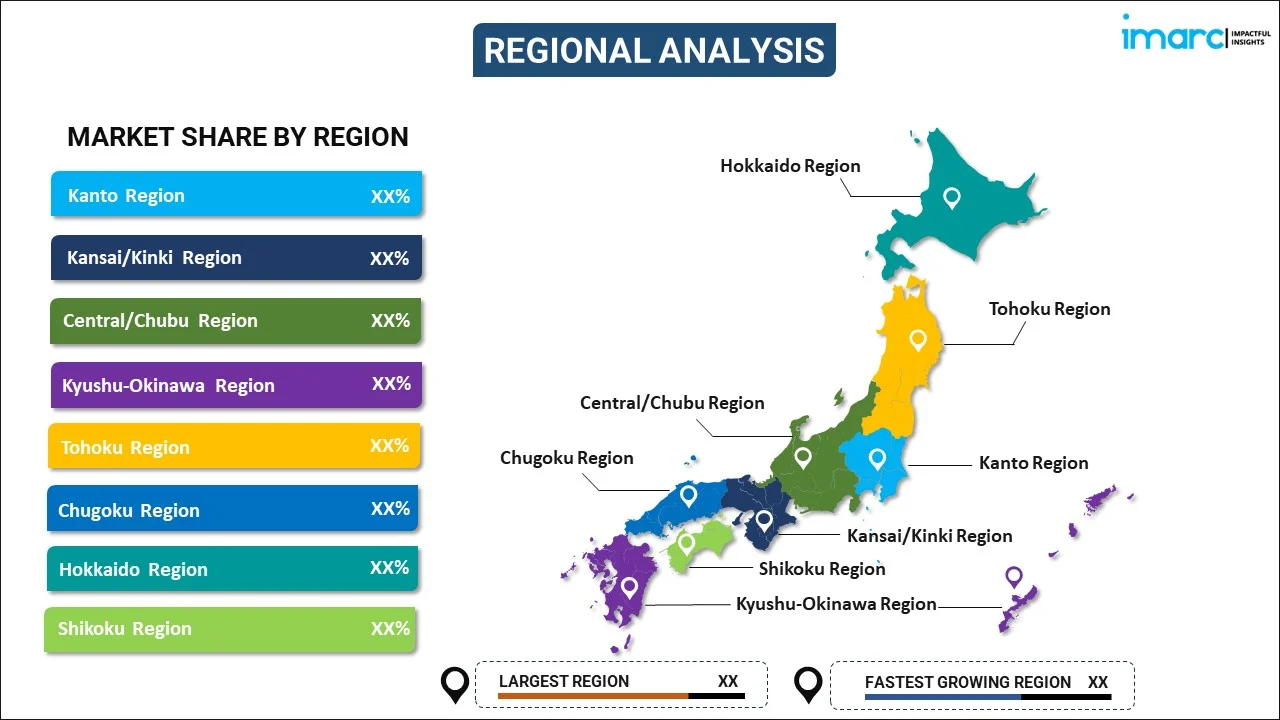
Japan Green Technology and Sustainability Market Report by Component (Solution, Services), Technology (Internet-of-Things, Cloud Computing, Artificial Intelligence and Analytics, Digital Twin, Cybersecurity, Blockchain), Industry Vertical (Green Building, Carbon Footprint Management, Weather Monitoring and Forecasting, Air and Water Pollution Monitoring, Forest Monitoring, Crop Monitoring, Soil Condition and Moisture Monitoring, Water Purification, and Others), and Region 2025-2033
Market Overview:
Japan green technology and sustainability market size reached USD 5.3 Billion in 2024. Looking forward, IMARC Group expects the market to reach USD 40.0 Billion by 2033, exhibiting a growth rate (CAGR) of 25.2% during 2025-2033. The increasing awareness and concern among individuals and businesses about environmental and social responsibility, emergence of circular economy practices, and rising support from governing authorities to promote environmental health represent some of the key factors driving the market.
|
Report Attribute
|
Key Statistics
|
|---|---|
|
Base Year
|
2024
|
|
Forecast Years
|
2025-2033
|
|
Historical Years
|
2019-2024
|
|
Market Size in 2024
|
USD 5.3 Billion |
|
Market Forecast in 2033
|
USD 40.0 Billion |
| Market Growth Rate 2025-2033 | 25.2% |
Green technology, also known as sustainable technology, refers to the development and utilization of innovative solutions that minimize the negative impact of human activities on the environment and promote long-term ecological balance. It incorporates sustainable practices and eco-friendly materials in various sectors to reduce resource consumption, pollution, and waste generation. It emphasizes efficiency in resource use and waste management, resulting in cost savings and reduced ecological footprint. It often relies on renewable energy sources like solar, wind, and hydropower to reduce dependence on fossil fuels. It helps mitigate climate change, protect biodiversity, reduce pollution, and safeguard the planet for future generations. It enables businesses and individuals to benefit from reduced energy bills, lower operational costs, and potential incentives for adopting green practices.
Japan Green Technology and Sustainability Market Trends:
The increasing awareness and concern among individuals and businesses about environmental and social responsibility represent one of the primary factors influencing the market positively in Japan. People are actively seeking eco-friendly products and services, and businesses are recognizing the importance of corporate sustainability as a competitive advantage. This demand for sustainable solutions is driving innovation across various sectors, including renewable energy and electric vehicles (EVs) to waste reduction and circular economy initiatives. Furthermore, the rising focus on technological innovation and research and development (R&D) activities is contributing to the growth of the market. Along with this, continuous advancements in areas, such as hydrogen fuel cells, advanced materials, and clean energy technologies. are facilitating the market growth. Key companies in Japan are investing in research activities to develop cutting-edge solutions that address domestic sustainability challenges and have global relevance. Moreover, the expansion of renewable energy sources and the increasing support from the governing authorities of the country to promote environmental health are strengthening the growth of the market. They are offering incentives and policies, such as feed-in tariffs and regulatory reforms, making it more attractive for investors and businesses to participate in the green energy sector. Additionally, the emergence of circular economic practices is creating a positive outlook for the market. Businesses are increasingly adopting circular economy strategies to minimize environmental impact and reduce resource dependency. This includes initiatives to reduce single-use plastics, promote product longevity, and improve recycling infrastructure. Moreover, the integration of digital technologies and data analytics is enhancing the efficiency and sustainability of various industries in Japan. Smart cities and the Internet of Things (IoT) solutions are deployed to optimize energy consumption, manage waste, and improve overall resource utilization. These technological advancements are contributing to a more sustainable urban environment in Japan.
Japan Green Technology and Sustainability Market Segmentation:
IMARC Group provides an analysis of the key trends in each segment of the market, along with forecasts at the country level for 2025-2033. Our report has categorized the market based on component, technology, and industry verticals.
Component Insights:

- Solution
- Services
The report has provided a detailed breakup and analysis of the market based on the component. This includes solution, and services.
Technology Insights:
- Internet-of-Things
- Cloud Computing
- Artificial Intelligence and Analytics
- Digital Twin
- Cybersecurity
- Blockchain
A detailed breakup and analysis of the market based on the technology have also been provided in the report. This includes internet-of-things, cloud computing, artificial intelligence and analytics, digital twin, cybersecurity, and blockchain.
Industry Verticals Insights:
- Green Building
- Carbon Footprint Management
- Weather Monitoring and Forecasting
- Air and Water Pollution Monitoring
- Forest Monitoring
- Crop Monitoring
- Soil Condition and Moisture Monitoring
- Water Purification
- Others
The report has provided a detailed breakup and analysis of the market based on the Industry Verticals. This includes green building, carbon footprint management, weather monitoring and forecasting, air and water pollution monitoring, forest monitoring, crop monitoring, soil condition and moisture monitoring, water purification, and others.
Regional Insights:

- Kanto Region
- Kansai/Kinki Region
- Central/ Chubu Region
- Kyushu-Okinawa Region
- Tohoku Region
- Chugoku Region
- Hokkaido Region
- Shikoku Region
The report has also provided a comprehensive analysis of all the major regional markets, which include Kanto Region, Kansai/Kinki Region, Central/ Chubu Region, Kyushu-Okinawa Region, Tohoku Region, Chugoku Region, Hokkaido Region, and Shikoku Region.
Competitive Landscape:
The market research report has also provided a comprehensive analysis of the competitive landscape. Competitive analysis such as market structure, key player positioning, top winning strategies, competitive dashboard, and company evaluation quadrant has been covered in the report. Also, detailed profiles of all major companies have been provided.
Japan Green Technology and Sustainability Market Report Coverage:
| Report Features | Details |
|---|---|
| Base Year of the Analysis | 2024 |
| Historical Period | 2019-2024 |
| Forecast Period | 2025-2033 |
| Units | Billion USD |
| Scope of the Report | Exploration of Historical Trends and Market Outlook, Industry Catalysts and Challenges, Segment-Wise Historical and Future Market Assessment:
|
| Components Covered | Solution, Services |
| Technologies Covered | Internet-of-Things, Cloud Computing, Artificial Intelligence and Analytics, Digital Twin, Cybersecurity, Blockchain |
| Industry Verticals Covered | Green Building, Carbon Footprint Management, Weather Monitoring and Forecasting, Air and Water Pollution Monitoring, Forest Monitoring, Crop Monitoring, Soil Condition and Moisture Monitoring, Water Purification, Others |
| Regions Covered | Kanto Region, Kansai/Kinki Region, Central/ Chubu Region, Kyushu-Okinawa Region, Tohoku Region, Chugoku Region, Hokkaido Region, Shikoku Region |
| Customization Scope | 10% Free Customization |
| Post-Sale Analyst Support | 10-12 Weeks |
| Delivery Format | PDF and Excel through Email (We can also provide the editable version of the report in PPT/Word format on special request) |
Key Questions Answered in This Report:
- How has the Japan green technology and sustainability market performed so far and how will it perform in the coming years?
- What has been the impact of COVID-19 on the Japan green technology and sustainability market?
- What is the breakup of the Japan green technology and sustainability market on the basis of component?
- What is the breakup of the Japan green technology and sustainability market on the basis of deployment technology?
- What is the breakup of the Japan green technology and sustainability market on the basis of industry verticals?
- What are the various stages in the value chain of the Japan green technology and sustainability market?
- What are the key driving factors and challenges in the Japan green technology and sustainability?
- What is the structure of the Japan green technology and sustainability market and who are the key players?
- What is the degree of competition in the Japan green technology and sustainability market?
Key Benefits for Stakeholders:
- IMARC’s industry report offers a comprehensive quantitative analysis of various market segments, historical and current market trends, market forecasts, and dynamics of the Japan green technology and sustainability market from 2019-2033.
- The research report provides the latest information on the market drivers, challenges, and opportunities in the Japan green technology and sustainability market.
- Porter's five forces analysis assist stakeholders in assessing the impact of new entrants, competitive rivalry, supplier power, buyer power, and the threat of substitution. It helps stakeholders to analyze the level of competition within the Japan green technology and sustainability industry and its attractiveness.
- Competitive landscape allows stakeholders to understand their competitive environment and provides an insight into the current positions of key players in the market.
Need more help?
- Speak to our experienced analysts for insights on the current market scenarios.
- Include additional segments and countries to customize the report as per your requirement.
- Gain an unparalleled competitive advantage in your domain by understanding how to utilize the report and positively impacting your operations and revenue.
- For further assistance, please connect with our analysts.
 Inquire Before Buying
Inquire Before Buying
 Speak to an Analyst
Speak to an Analyst
 Request Brochure
Request Brochure
 Request Customization
Request Customization




.webp)




.webp)












